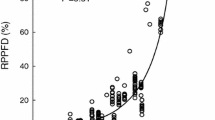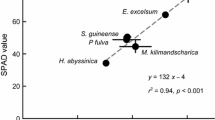Abstract
We investigated leaf physiological traits of dominant canopy trees in four lowland Panamanian forests with contrasting mean annual precipitation (1,800, 2,300, 3,100 and 3,500 mm). There was near complete turn-over of dominant canopy tree species among sites, resulting in greater dominance of evergreen species with long-lived leaves as precipitation increased. Mean structural and physiological traits changed along this gradient as predicted by cost–benefit theories of leaf life span. Nitrogen content per unit mass (Nmass) and light- and CO2-saturated photosynthetic rates per unit mass (P mass) of upper canopy leaves decreased with annual precipitation, and these changes were partially explained by increasing leaf thickness and decreasing specific leaf area (SLA). Comparison of 1,800 mm and 3,100 mm sites, where canopy access was available through the use of construction cranes, revealed an association among extended leaf longevity, greater structural defense, higher midday leaf water potential, and lower P mass, Nmass, and SLA at wetter sites. Shorter leaf life spans and more enriched foliar δ15N values in drier sites suggest greater resorption and re-metabolism of leaf N in drier forest. Greater dominance of short-lived leaves with relatively high P mass in drier sites reflects a strategy to maximize photosynthesis when water is available and to minimize water loss and respiration costs during rainless periods. Overall, our study links coordinated change in leaf functional traits that affect productivity and nutrient cycling to seasonality in lowland tropical forests.






Similar content being viewed by others
References
Ackerly DD, Reich PB (1999) Convergence and correlations among leaf size and function in seed plants: a comparative test using independent contrasts. Am J Bot 86:1272–1281
ACP (2002) Panama Canal Authority, Meteorology and Hydrology Branch, Republic of Panama
Aerts R, Chapin FS III (2000) The mineral nutrition of wild plants revisited: a re-evaluation of processes and patterns. Adv Ecol Res 30:1–66
Austin AT, Vitousek PM (1998) Nutrient dynamics on a precipitation gradient in Hawai’i. Oecologia 113:519–529
Björkman O, Demmig B (1987) Photon yield of O2 evolution and chlorophyll fluorescence characteristics at 77 K among vascular plants of diverse origins. Planta 170:489–504
Chabot BF, Hicks DJ (1982) The ecology of leaf life spans. Annu Rev Ecol Syst 13:229–259
Condit R (1998) Ecological implications of changes in drought patterns: Shifts in forest composition in Panama. Clim Change 39:413–427
Condit R, Pitman N, Leigh EG, Chave J, Terborgh J, Foster RB, Nuñez P, Aguilar S, Valencia R, Villa G, Muller-Landau HC, Losos E, Hubbell SP (2002) Beta-diversity in tropical forest trees. Science 295:666–669
Croat TB (1978) Flora of Barro Colorado Island. Stanford University Press, Stanford, Calif.
Cunningham SA, Summerhayes B, Westoby M (1999) Evolutionary divergences in leaf structure and chemistry, comparing rainfall and soil nutrient gradients. Ecol Monogr 69:569–588
Deka RN, Wairiu M, Mtakwa PW, Mullins CE, Veenendaal EM, Townsend J (1995) Use and accuracy of the filter-paper technique for measurement of soil matric potential. Eur J Soil Sci 46:233–238
Delieu T, Walker D (1981) Polarographic measurement of photosynthetic oxygen evolution by leaf-disks. New Phytol 89:165–178
Dietrich WE, Windsor DM, Dunne T (1982) Geology, climate, and hydrology of Barro Colorado Island. In: Leigh EG, Rand AS, Windsor DM (eds) The ecology of a tropical forest. Smithsonian Institution Press, Washington, DC, pp 21–46
Eamus D, Prior L (2001) Ecophysiology of trees of seasonally dry tropics: comparisons among phenologies. Adv Ecol Res 32:113–197
Ende CN von (1993) Repeated-measures analysis: growth and other time-dependent measures. In: Gurevitch J, Scheiner SM (eds) Design and analysis of ecological experiments. Chapman and Hall, NY, pp 113–137
Evans RD (2001) Physiological mechanisms influencing plant nitrogen isotope composition. Trends Plant Sci 6:121–126
Gentry AH (1988) Changes in plant community diversity and floristic composition on environmental and geographical gradients. Ann Mo Bot Garden 75:1–34
Givnish TJ (2002) Adaptive significance of evergreen vs. deciduous leaves: solving the triple paradox. Silva Fenn 36:703–743
Goldstein G, Andrade JL, Meinzer FC, Holbrook NM, Cavelier J, Jackson P, Celis A (1998) Stem water storage and diurnal patterns of water use in tropical forest canopy trees. Plant Cell Environ 21:397–406
Graham EA, Mulkey SS, Kitajima K, Phillips NG, Wright SJ (2003) Cloud cover limits net CO2 uptake and growth of a rainforest tree during tropical rainy seasons. Proc Natl Acad Sci 100:572–576
Jackson RB, Anderson LJ, Pockman WT (2000) Measuring water availability in ecosystem studies. In: Sala OE, Jackson RB, Mooney HA, Howarth RW (eds) Methods in ecosystem science. Springer, Berlin Heidelberg New York, pp 199–214
Kikuzawa K (1991) A cost–benefit analysis of leaf habit and leaf longevity of trees and their geographic pattern. Am Nat 138:1250–1263
Kursar TA, Wright SJ, Radulovich R (1995) The effects of the rainy season and irrigation on soil water and oxygen in a seasonal forest in Panama. J Trop Ecol 11:497–516
Mediavilla S, Escudero A (2003) Photosynthetic capacity, integrated over the lifetime of a leaf, is predicted to be independent of leaf longevity in some tree species. New Phytol 159:203–211
Monk CD (1966) An ecological significance of evergreenness. Ecology 47:504–505
Mooney HA, Ferrar PJ, Slatyer RO (1978) Photosynthetic capacity and carbon allocation patterns in diverse growth forms of Eucalyptus. Oecologia 36:103–111
Niinemets Ü (2001) Global-scale climate controls of leaf dry mass per area, density, and thickness in trees and shrubs. Ecology 82:453–469
Paton S, Wright SJ (2003) Terrestrial environmental science program http://www.stri.org/tesp/. Smithsonian Tropical Research Institute, Balboa, Republic of Panama
Pitman NCA, Terborgh JW, Silman MR, Nuñez P, Neill DA, Ceròn CE, Palacios WA, Aulestia M (2001) Dominance and distribution of tree species in upper Amazonian terre firme forests. Ecology 82:2101–2117
Posada JM (2003) Optimization of light use by tropical canopy trees through acclimation of leaf physiology and orientation. PhD dissertation, University of Florida, Gainesville, Fla.
Pyke CR, Condit R, Aguilar S, Lao S (2001) Floristic composition across a climatic gradient in a neotropical lowland forest. J Veg Sci 12:553–566
Reich PB, Walters MB, Ellsworth DS (1997) From tropics to tundra: global convergence in plant functioning. Proc Natl Acad Sci 94:13730–13734
Reich PB, Ellsworth DS, Walters MB, Vose JM, Gresham C, Volin JC, Bowman WD (1999) Generality of leaf trait relationships: a test across six biomes. Ecology 80:1955–1969
Santiago LS (2003) Leaf traits of canopy trees on a precipitation gradient in Panama: integrating plant physiological ecology and ecosystem science. PhD dissertation, University of Florida, Gainesville, Fla.
SAS (1985) SAS user’s guide. SAS Institute, Cary, NC
Schimper AFW (1903) Plant geography upon a physiological basis. Clarendon, Oxford
Schuur EAG (2003) Productivity and global climate revisited: the sensitivity of tropical forest growth to precipitation. Ecology 84:1165–1170
Schuur EAG, Matson PA (2001) Net primary productivity and nutrient cycling across a mesic to wet precipitation gradient in Hawaiian montane forest. Oecologia 128:431–442
Vázquez JA, Givnish T (1998) Altitudinal gradients in tropical forest composition, structure, and diversity in the Sierra de Manantlán. J Ecol 86:999–1020
Werger MJA, Morris JW (1991) Climatic control of vegetation structure and leaf characteristics along an aridity gradient. Ann Bot IL:203–215
Wright SJ (1992) Seasonal drought, soil fertility and the species density of tropical forest plant communities. Trends Ecol Evol 7:260–263
Yavitt JB (2000) Nutrient dynamics of soil derived from different parent material on Barro Colorado Island, Panama. Biotropica 32:198–207
Yavitt JB, Wieder RK, Wright SJ (1993) Soil nutrient dynamics in response to irrigation of a Panamanian tropical moist forest. Biogeochemistry 19:1–25
Acknowledgements
We gratefully acknowledge: R. Condit, S. Lao and the Center for Tropical Forest Science for field sites; the Smithsonian Tropical Research Institute (STRI) for logistical support; K. Silvera, A. Somoza, E. Osorio, S. Davis, E. Graham, A. Virgo, D. Noletti, K. Moran and S. Bouchard for field and laboratory assistance; F.E. Putz, F.C. Meinzer, E.A. Herre, K. Winter, T. Kursar, S. Bray, M. Mack, T. Schuur and T. Martin for comments on earlier versions of the project. This research was supported by an EPA STAR graduate fellowship, a STRI short-term fellowship, the Florida-Georgia Alliance, and a Mellon Foundation exploratory grant through STRI.
Author information
Authors and Affiliations
Corresponding author
Rights and permissions
About this article
Cite this article
Santiago, L.S., Kitajima, K., Wright, S.J. et al. Coordinated changes in photosynthesis, water relations and leaf nutritional traits of canopy trees along a precipitation gradient in lowland tropical forest. Oecologia 139, 495–502 (2004). https://doi.org/10.1007/s00442-004-1542-2
Received:
Accepted:
Published:
Issue Date:
DOI: https://doi.org/10.1007/s00442-004-1542-2




